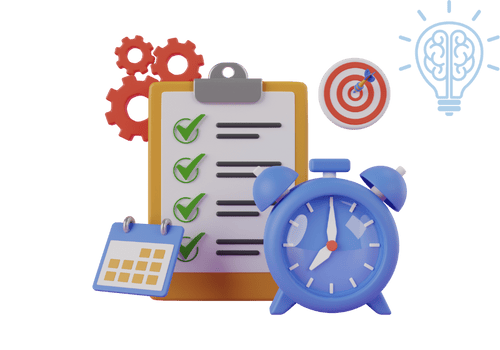What Is the Double It Rule?
The Double It Rule is a time management strategy that suggests you should estimate how long a task will take—and then double that estimate. This rule helps counteract the planning fallacy, which causes people to underestimate the time required for tasks.
By applying the Double It Rule, individuals can set more realistic expectations, reduce last-minute stress, and plan their time more effectively. This method is particularly useful for students, professionals, and anyone struggling with executive function challenges like time blindness and procrastination.
Why Does the Double It Rule Work?
Most people underestimate how long tasks will take due to cognitive biases. The Double It Rule works by adjusting for these biases, leading to more accurate time predictions and better planning.
Common reasons we underestimate time:
- Planning Fallacy – We assume tasks will go smoothly and forget about obstacles.
- Optimism Bias – We believe we can work faster than reality allows.
- Ignoring Past Experience – We don’t learn from previous miscalculations.
- Distractions & Interruptions – We fail to account for unexpected delays.
By doubling our initial estimate, we build in extra time to handle unforeseen challenges, reducing stress and improving task completion rates.
How the Double It Rule Supports Executive Function
Executive function skills like time management, planning, and self-monitoring are essential for completing tasks efficiently. The Double It Rule strengthens these skills by encouraging:
- Time Awareness: Helps individuals recognize how long tasks truly take.
- Task Prioritization: Encourages better scheduling and organization.
- Self-Monitoring: Allows for reflection on past time estimation mistakes.
- Proactive Planning: Reduces last-minute stress by accounting for potential setbacks.
How to Use the Double It Rule Effectively
Applying the rule is simple, but it works best when combined with structured planning techniques.
✅ 1. Estimate the Time Needed for a Task
Before starting, make an educated guess about how long the task will take.
✅ 2. Double That Estimate
If you think a task will take 30 minutes, schedule at least 60 minutes instead.
✅ 3. Track Actual Time Spent
Use a timer or journal to measure how long tasks actually take.
✅ 4. Adjust Future Estimates
Compare your estimated vs. actual time and refine your predictions over time.
✅ 5. Use Time Blocking
Schedule extra buffer time in your calendar to prevent overbooking.
When Should You Use the Double It Rule?
The Double It Rule is especially helpful for:
- 📚 Studying & Homework – Prevents last-minute cramming.
- 💼 Work Projects – Helps manage deadlines and workload.
- 🚀 Creative Work – Allows space for idea development.
- 🏠 Household Chores – Keeps tasks from taking longer than expected.
- 📅 Event Planning – Ensures everything runs smoothly with extra preparation time.
Limitations of the Double It Rule
While the Double It Rule is a useful guideline, it’s not foolproof. Some tasks may still take longer than twice the estimated time, while others may not need as much adjustment.
Situations where doubling time may not be necessary:
- Highly repetitive tasks where time is predictable.
- Short, simple tasks that don’t involve multiple steps.
- Tasks with set time constraints (e.g., a 30-minute meeting).
The best approach is to combine the Double It Rule with other time management strategies, like time tracking and task batching, for the most accurate planning.
How Executive Function Coaching Can Help
If you struggle with time blindness, procrastination, or task completion, executive function coaching can provide personalized strategies to improve time estimation and planning skills.
Coaching can help with:
- Identifying time-wasting patterns and distractions.
- Strengthening self-monitoring to refine time estimates.
- Implementing structured planning techniques to improve efficiency.
- Developing personalized time management systems for better productivity.
By applying the Double It Rule and other executive function strategies, individuals can gain better control over their schedules, reduce last-minute stress, and improve overall productivity.
📞 Want to improve your time management skills? Contact us for executive function coaching today!




